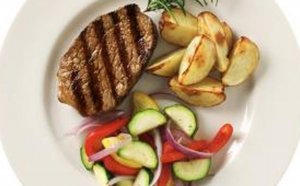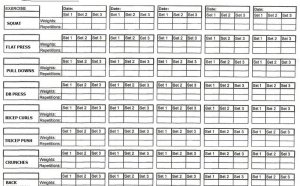
Ideal Workout routine
Now let me explain what the hell that actually means.
Calorie Maintenance Level
Every person has a certain number of calories that they need to eat each day in order to maintain their current weight. This is what’s known as your calorie maintenance level.
There are a bunch of complicated ways to estimate what your maintenance level is, but the quickest and simplest way is to just multiply your current body weight (in pounds) by 14 and 18.
Somewhere in between those 2 amounts will usually be your daily calorie maintenance level.
If you’re more active and/or think you have a fast metabolism, then you should probably use the higher end of that range. If you’re less active and/or think you have a slow metabolism, then you should probably use the lower end of that range.
If you’re unsure, just pick a number in the middle. We’ll make sure it’s perfectly accurate later on. Don’t worry.
Next, pick your goal…
If Your Primary Goal Is Losing Fat…
In order to lose fat, you must consume LESS calories per day than your maintenance level amount. Doing so creates a caloric deficit, and this forces your body to start burning your stored body fat for energy.
Meaning, a caloric deficit is a fat loss requirement.
As I mentioned before, the most often recommended caloric deficit is about 20% below your maintenance level. So, let’s do some basic first grade level math.
For example, if your estimated calorie maintenance level is 2500 calories per day, you’d figure out that 20% of 2500 is 500 (2500 x .20 = 500). Then you’d just subtract that 500 from 2500 and get 2000.
In this example, this person would need to eat 2000 calories per day to lose fat.
If Your Primary Goal Is Building Muscle…
In order to build muscle, you must consume MORE calories per day than your maintenance level. Doing so creates a caloric surplus, and this provides your body with the calories it needs to actually create new muscle tissue.
Meaning, a caloric surplus is a muscle building requirement.
As I mentioned before, the ideal caloric surplus for most guys is about 250 calories above your maintenance level, and around half that for girls. So, let’s do some basic first grade level math.
For example, a man with an estimated calorie maintenance level of 2500 calories per day would add 250 or so calories to it and get about 2750.
In this example, this person would need to eat about 2750 calories per day to build muscle at an ideal rate.
Ensuring That Your Calorie Intake Is Correct
Since our calorie intake is based on an estimate, it’s possible it can be a little off. Luckily, there’s a very simple way to double check it.
Weigh yourself once per week first thing in the morning before you eat or drink anything (or weigh in daily and take the weekly average). Then, just monitor what your weight does from week to week.
- If your goal is losing fat, you should end up losing between 0.5-2lbs per week (closer to 2lbs if you have a lot of fat to lose, closer to 0.5lbs if you only have a little fat to lose, or somewhere in the middle if you have an average amount to lose). If you are losing weight slower than that or not at all, then reduce your calorie intake by an additional 250 calories. If you are losing weight faster than that, then increase your calorie intake by about 250 calories.
- If your goal is building muscle (or increasing strength), you should end up gaining about 0.5lb per week (or about 2lbs per month). And again for women, it should be about half that. If you are consistently gaining weight faster than that, reduce your calorie intake by about 250 calories. If you are gaining weight slower than that or not at all, then increase your calorie intake by about 250 calories.
Basically, just consistently weigh yourself each week and make sure your weight is moving in the right direction at the optimal rate that I just described.
If is it, perfect! Keep eating that amount of calories each day.
If it isn’t, then just adjust your calorie intake in 250 calorie increments until it is. Simple as that.
Step 2: Protein Intake
The most common recommendation for the daily protein intake of healthy adults who are weight training regularly is:
Between 0.8 – 1.5 grams of protein per pound of body weight. An even 1 gram of protein per pound is probably the most common recommendation of all.
So, for example, if you weigh 175lbs, you’d shoot for about 175 grams of protein per day (or a little more if you prefer it).
High protein foods include chicken, fish, turkey, lean meats, eggs/egg whites, milk, protein supplements and to a lesser extent nuts and beans as well.
Step 3: Fat Intake
The most common recommendation for your daily fat intake is:
Fat should account for between 20-30% of your total calorie intake, with an even 25% probably being most common.
For that to make sense, you need to know that 1 gram of fat contains 9 calories.
So, for example, if your ideal calorie intake is 2000 calories per day, you’d first figure out that 25% of 2000 is 500. Then, you’d divide 500 by 9 and figure out that you’d need to eat about 55 grams of fat per day in this example.
Foods high in the “healthy fats” that should account for the majority of your fat intake include fish, fish oil supplements, nuts (peanuts, almonds, walnuts, etc.), seeds, and olive oil.
Step 4: Carb Intake
The most common recommendation for your daily carb intake is:
However many calories are left after a sufficient protein and fat intake have been factored in… those calories should come from carbs.
INTERESTING VIDEO



Share this Post
Related posts
Best weight Loss Workout routine
By following a diet such as this one, you are priming your body to burn fat instead of muscle. By cycling your carbs, your…
Read MoreMens Health workout Routines
Make mobility a priority. Dial it back in the weight room during your first workout back in the gym. The reason: If you go…
Read More









